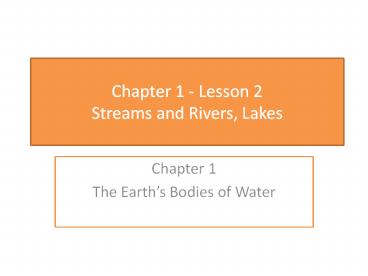Chapter 1 - Lesson 2 Streams and Rivers, Lakes - PowerPoint PPT Presentation
Title:
Chapter 1 - Lesson 2 Streams and Rivers, Lakes
Description:
Chapter 1 - Lesson 2 Streams and Rivers, Lakes Chapter 1 The Earth s Bodies of Water Water covers more than 70% of the Earth Water is in the ground and in the air ... – PowerPoint PPT presentation
Number of Views:252
Avg rating:3.0/5.0
Title: Chapter 1 - Lesson 2 Streams and Rivers, Lakes
1
Chapter 1 - Lesson 2 Streams and Rivers, Lakes
- Chapter 1
- The Earths Bodies of Water
2
Streams and Rivers page 26
- Water covers more than 70 of the Earth
- Water is in the ground and in the air we breathe
- People, Plants, and Animals all need water to
live
Weathering - is the process of breaking up rocks
into smaller pieces called sediment
3
Streams and Rivers
- Streams are bodies of water that flow over land
in a channel - Most streams begin on high ground, among hills or
mountains - The sources of a stream usually consist of
melting snow/ice or an overflowing lake - At the end of a stream is the mouth which empties
into another body of water
4
Streams and Rivers
- Streams can be as small as a shallow brook
- Or as large as a river, the largest and most
important streams - Most rivers form from many smaller streams coming
together, these are called tributaries
Tributaries are streams or rivers that flow
into a larger stream or river
5
Streams and Rivers
- The more tributaries that empty into a river the
larger the river grows - Together the river and its tributaries are called
a river system
River System a river and all of its tributaries
6
Streams and Rivers
- Each continent, except Antarctica, has major
rivers and river systems. - Africa has the Nile, Asia has the Yangtze,
Australia has the Murray, Europe has the Danube,
North America has the Mississippi, and South
America has the Amazon
7
Streams and Rivers, Lakes
- The Nile is the Earths longest river, it flows
from Central Africa to the Mediterranean Sea - The Amazon is the Earths largest river, carrying
more water than the Mississippi, Nile and Yangtze
combined - River Systems carry or drain water away from the
land around them (drainage basin) - Rivers are important for many reasons including
drinking, cleaning, travel and trade
Drainage Basin Land drained by a river system
8
Streams and Rivers
Drainage Basin
9
- Why did many of the worlds first settlements
form along rivers? - (pg.27)
10
Lakes
- Lakes are bodies of water surrounded by land
- The word lake comes from the Greek language
meaning hole because most lakes are holes in the
Earth that fill with water - Lakes exist on every continent except Antartica
- The greatest amount of lakes exist where there
was once many glaciers such as North America and
northern Europe
11
Lakes
- During the last Ice Age, glaciers gouged huge
holes in the Earth and the holes filled with the
water from the melted glaciers - Lakes also form where rainwater collects in huge
holes made in other ways - Crater Lake in Oregon was formed in a crater of
an extinct volcano
12
Lakes
- Lake Baikal in Russia is the deepest lake on
Earth measuring 5,315 feet deep it was formed in
a huge crack in the Earths crust called a rift
Rift a long and deep crack in the Earth
13
Lakes
- North America has the most lakes out of all of
the continents - The largest of the North American lakes are the
Great Lakes - One fifth of all of the fresh water on the
Earths surface is found in the Great Lakes
H Huron O Ontario M Michigan E Erie S
Superior
14
Lakes
- There are some large bodies of water called seas
that are actually lakes - The difference is that they are not fresh water,
but salt water and that is why they are called
seas instead of lakes - The Dead Sea, Sea of Galilee, and the Caspian Sea
are lakes - The lowest lying lake is the Dead Sea between
Israel and Jordan - The highest lake is Lake Titicaca in South America
15
Lakes
The Dead Sea
16
Lakes
Lake Titicaca
17
Lakes
- Not all lakes are made by nature
- Some are man-made and are called resevoirs
- People build dams to control river flooding or to
generate electricity
Reservoir a lake that forms behind a human made
dam
18
Terms to Know
- Reservoir
- Rift
- Drainage basin
- River system
- Tributaries
- How did Ice Age glaciers form lakes in North
America and Europe? (pg. 28)































